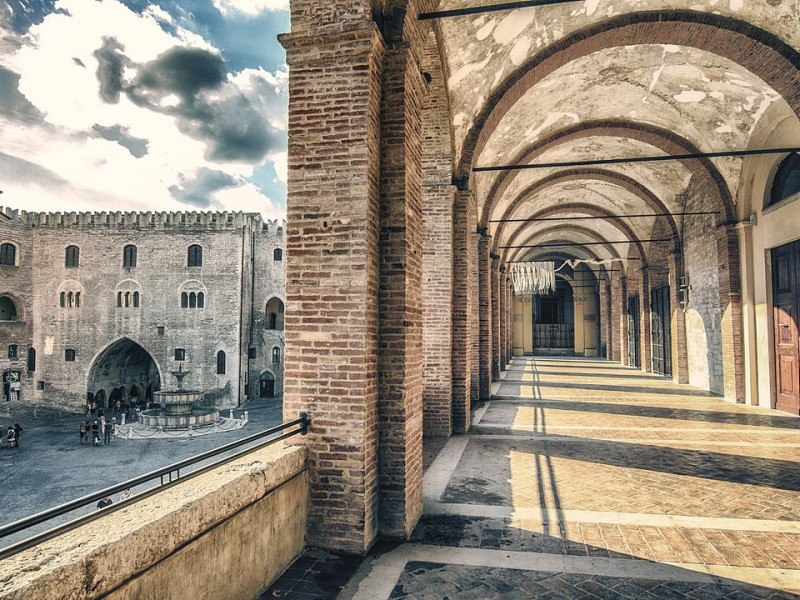Fabriano
Fabriano is a town and comune of Ancona province in the Italian region of the Marche, at 325 metres (1,066 ft) above sea level. It lies in the Esino valley 44 kilometres (27 mi) upstream and southwest of Jesi; and 15 kilometres (9 mi) east-northeast of Fossato di Vico and 36 kilometres (22 mi) east of Gubbio (both in Umbria). Its location on the main highway and rail line from Umbria to the Adriatic make it a mid-sized regional center in the Apennines. Fabriano is the headquarters of the giant appliance maker Indesit. Fabriano, with Bologna, is the only Italian creative city (UNESCO). The town is in the category Folk Arts (for the Fabriano's handmade paper production). History Fabriano appears to have been founded in the early Middle Ages by the inhabitants of a small Roman town 5 kilometres (3 mi) south at Attiggio (Latin Attidium), of which some slight remains and inscriptions are extant. Fabriano itself was one of the earliest places in Europe to make high-quality paper on an industrial scale, starting in the 13th century, and the town even today has a reputation for fine watermarked paper. This led to Fabriano's prosperity in the Late Middle Ages and the Renaissance, and was also one of the factors that led to the establishment of nearby Foligno in Umbria as one of the earliest printing centers in Italy in the 15th century, from 1470 onwards. Main sights Fabriano's wealth and commitment to the fine arts in the late medieval period have left it with many monuments. Churches The Cathedral of St. Venantius (14th century, rebuilt in 1607–17). From the Baroque restoration are the stucco decoration of the interior and the canvasses by Gregorio Preti, Salvator Rosa, Giovanni Francesco Guerrieri, Giuseppe Puglia and Orazio Gentileschi. To the original Cathedral belong the polygonal apse, the cloister and the St Lawrence Chapel with frescoes by Allegretto di Nuzio (c. 1360). Also important are the frescoes with Stories of the True Cross by the Folignate painter Giovanni di Corraduccio (1415). San Domenico Santi Blaise and Romuald Sant'Onofrio St Philip The Benedictine Abbey St Augustine St Catherine Collegiata of St. Nicholas Santa Maria del Piangato St Benedict Oratory of the Gonfalone Other buildings Palazzo del Podestà (1255) built in white stone from Vallemontagnana and subsequently modified several times. It has a distinctive bridge structure, a memory of the stream which once flowed under it. The central arcade has frescoes from the 13th-14th centuries portraying warriors, and an enigmatic Wheel of Fortune moved by a feminine figure. Sturinalto Fountain (1285), designed by Jacopo di Grondolo, who was inspired by the Fontana Maggiore in Perugia. Communal Palace (c. 1350, rebuilt in 1690). It was the residence of the Chiavelli family, lords of the city until 1435. In the courtyard is a lapidarium with fragments of buildings of the ancient Roman cities of Attidium (Attiggio), Tuficum (Borgo Tufico) and Sentinum (Sassoferrato). Pinacoteca Civica Bruno Malajoli displayed in the former Hospital (Spedale di Santa Maria del Buon Gesù) - The hospital was first built in 1456. The art collection of the Pinacoteca were moved here in 1994. The collection contains works by Rainaldetto di Ranuccio of Spoleto, Master of San Agostino, Master of San Emiliano, Master of the Magi (Fra Giovanni di Bartolomeo), Maestro dei Beati Becchetti, Puccio di Simone, Allegretto Nuzi, Franceschino di Cecco, Francescuccio di Cecco Ghissi, Master of Fossato, Master of San Verecondo, Ottaviano Nelli, Master of Staffolo, Antonio da Fabriano, Bicci di Lorenzo, Neri di Bicci; Bernardino di Mariotto, Filippo da Verona, Venanzio da Camerino and Piergentile da Matelica, Simone de Magistris, Domiziano Domiziani, Girolamo or Giacomo Nardini, Andrea Boscoli, Orazio Gentileschi, Ambrogio Monaco, Francesco Podesti, and Gentile da Fabriano. Loggiato of St. Francis (c. 1450) Vasari Portico (1316) Museum of Paper People Gentile da Fabriano, 15th-century painter, whose most famous work, an oil painting of the Epiphany, is in the Uffizi Gallery in Florence. Saint John dal Bastone 12th-century Silvestrine monk, born in Paterno. Jessica Rizzo (born 1964), an actress and businesswoman. Frazioni Frazioni of Fabriano are: Albacina, Argignano, Attiggio, Bassano, Bastia, Belvedere, Borgo Tufico, Cacciano, Ca' Maiano, Campodiegoli, Campodonico, Cancelli, Cantia, Castelletta, Ceresola, Ciaramella, Coccore, Collamato, Collegiglioni, Colle Paganello, Cupo, Fontanaldo, Grotte, Marena, Marenella, Marischio, Melano, Moscano, Nebbiano, Paterno, Poggio San Romualdo, Precicchie, Rocchetta, Rucce, San Donato, San Giovanni, San Michele, San Pietro, Sant'Elia, Serradica, Valgiubbola, Vallemontagnana, Valleremita, Vallina, Varano, Viacce, Vigne. External links Official website Museo della Carta (Paper making museum) Fabriano Storica - history, art, culture, legend, curiosity Mapquest - Fabriano Bill Thayer's site Made in Fabriano Academy (Incorporates text from Bill Thayer's Gazetteer of Italy, by permission.)

